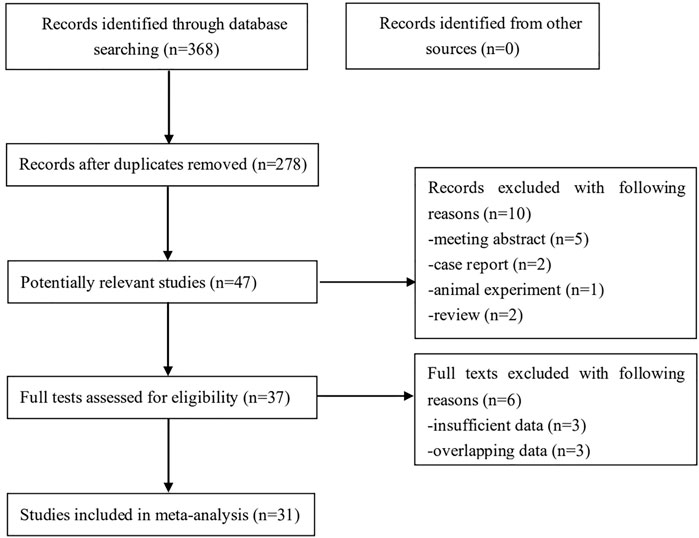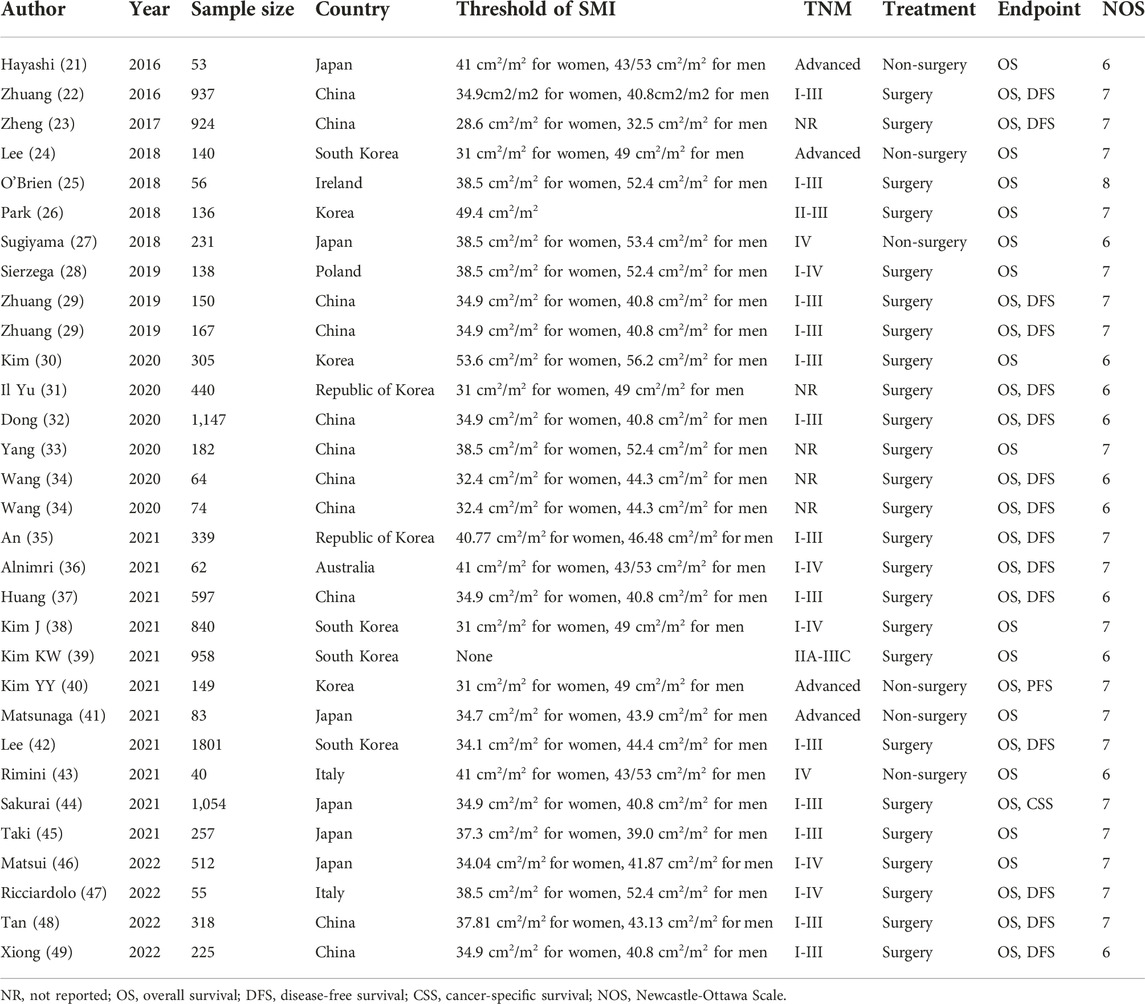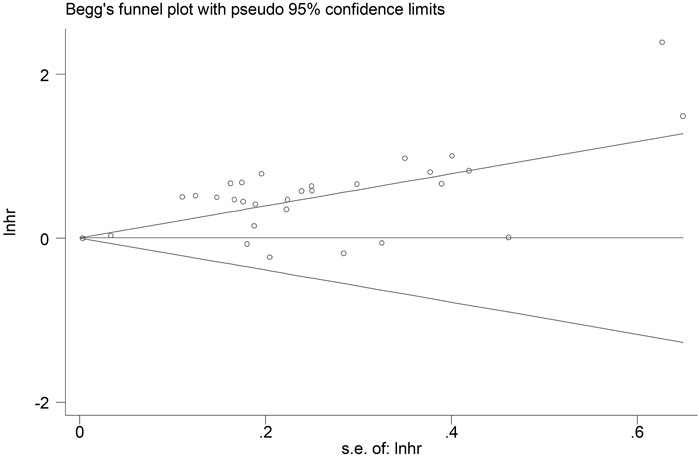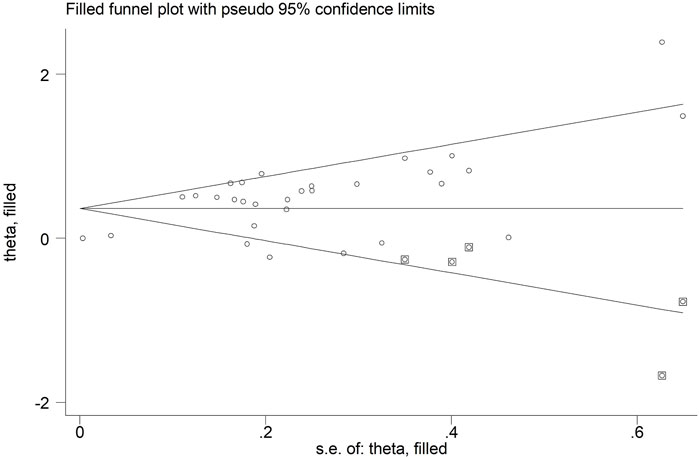- 1Cancer Center, West China Hospital, Sichuan University, Chengdu, China
- 2Outpatient Department, West China Hospital, Sichuan University/West China School of Nusing Sichuan University, Chengdu, China
Background: The association between pretreatment skeletal muscle index (SMI) and long-term survival of gastric cancer patients remains unclear up to now. The aim of this meta-analysis was to identify the prognostic value of pretreatment SMI in gastric cancer.
Methods: The PubMed, EMBASE and Web of Science electronic databases were searched up to 5 June 2022 for relevant studies. The primary outcome was overall survival (OS) and the second outcomes were disease-free survival (DFS) and cancer-specific survival (CSS). The hazard ratios (HRs) and 95% confidence intervals (CIs) were combined to assess the relationship between pretreatment SMI and survival of gastric cancer patients. All statistical analyses were conducted by STATA 15.0 software.
Results: A total of 31 retrospective studies involving 12,434 patients were enrolled in this meta-analysis. The pooled results demonstrated that lower pretreatment was significantly associated with poorer OS (HR = 1.53, p < 0.001). Besides, lower pretreatment SMI was also related with worse DFS (HR = 1.39, p < 0.001) and CSS (HR = 1.96, p < 0.001).
Conclusion: Pretreatment SMI was significantly associated with prognosis of gastric cancer patients and lower SMI predicted worse survival. However, more prospective high-quality studies are still needed to verify our findings.
Introduction
Gastric cancer remains the sixth highest incidence of all cancer worldwide with over none million newly diagnosed cases every year and is also the second-leading cause of cancer-related death (1). Despite of the great advances in the early diagnosis and treatment strategies including the screening of gastroscopy, surgical techniques and neoadjuvant chemoradiotherapy, the prognosis of gastric cancer patients remains extremely poor and about half of gastric cancer patients may recur after curative treatment, which is a severe global health problem needing to be solved (2, 3). It is still necessary to identify more valuable and reliable clinical indicators to precisely estimate the prognosis of gastric cancer patients.
It is well known that the nutrition condition of the body plays an essential role in the development and progression of cancers. In overall, a poor nutrition condition could promote the occurrence and progression of cancers and malnutrition leads to a decline in the antineoplastic ability of patients (4, 5). Besides, the nutritional status could help predict long-term survival of cancer patients (4, 5). In recent years, a number of clinical parameters which could reflect the nutritional status to a certain extent have been introduced and reported to show high prognostic value in gastric cancer such as the controlling nutritional status (CONUT) score, prognostic nutritional index (PNI) and geriatric nutritional risk index (GNRI) (6–8). Unfortunately, none of these parameters are widely applied in clinics because they are unstable and could be affected by many factors.
Skeletal muscle loss is a strong and reliable indicator for poor nutritional status and closely related with survival of cancer patients (9–11). In recent years, skeletal muscle index has been introduced and it is calculated based on the third lumbar vertebra (L3) level skeletal muscle area and squared height (12). Meanwhile, the skeletal muscles in the L3 level include the e psoas muscles, the para-spinal muscles, and the abdominal wall muscles. Furthermore, the prognostic value of pretreatment SMI in several cancers has been well verified such as the epithelial ovarian cancer, colorectal cancer and hepatocellular carcinoma (13–15). However, the prognostic role of pretreatment SMI in gastric cancer remains unclear.
Thus, the aim of this meta-analysis was to demonstrate the prognostic value of pretreatment SMI in gastric cancer, which might contribute to predicting and improving the clinical outcomes of gastric cancer patients.
Materials and methods
This systematic review and meta-analysis were conducted according to the Preferred Reporting Items for Systematic Reviews and Meta-Analyses guidelines (16).
Literature search
The PubMed, EMBASE and Web of Science electronic databases were searched up to 5 June 2022. The following key words were used during the search: skeletal muscle index, SMI, stomach, gastric, neoplasm, cancer, tumor, carcinoma, survival, prognosis and prognostic. A combination of subject terms and free words was applied. The detailed search strategy was as follows: (skeletal muscle index OR SMI) AND (stomach OR gastric) AND (cancer OR tumor OR neoplasm OR carcinoma) AND (prognosis OR survival OR prognostic). Besides, the references cited in included studies were also reviewed for eligibility.
Inclusion and exclusion criteria
The inclusion criteria were as follows: 1) patients were pathologically diagnosed with primary gastric cancer; 2) the SMI was calculated before any anti-tumor treatment such as the surgery, chemotherapy and radiotherapy; 3) the association between pretreatment SMI and survival of gastric cancer patients were explored and the corresponding hazard ratios (HRs) and 95% confidence intervals (CIs) were reported in articles directly; 4) the outcomes included at least one of the following endpoints: overall survival (OS), disease-free survival (DFS) and cancer-specific survival (CSS).
The exclusion criteria were as follows: 1) meeting abstracts, animal trials, case reports, reviews or editorials; 2) HRs with corresponding 95% CIs were unavailable; 3) full texts were not available; 4) low-quality studies with the Newcastle-Ottawa Scale (NOS) score of 5 or lower (17).
Data collection and quality assessment
In this meta-analysis, the following information was collected from included studies: the name of first author, publication year, sample size, country, threshold of SMI, tumor-node-metastasis (TNM) stage, treatment, endpoint, HR and corresponding 95% CI.
The NOS was applied to evaluate the quality of included studies and only high-quality studies with a NOS score of 6 or higher were included (17).
The literature search, selection, data collection and quality assessment were all performed by two authors independently.
Statistical analysis
All statistical analyses were conducted with STATA 15.0 software. The HRs with corresponding 95% CIs were calculated to evaluate the association between pretreatment SMI and prognosis of gastric cancer patients. The heterogeneity among the included studies was evaluated by I2 statistics and Q test. When significant heterogeneity was observed representing as I2 > 50% and (or) p < 0.1, the random effects model was applied; otherwise, the fix effects model was used. The sensitivity analysis was performed to detect the sources of heterogeneity and evaluate the stability of pooled results. Furthermore, the Begg’s funnel plot and Egger’s test were conducted to detect publication bias and significant publication bias was defined as p < 0.05 (18, 19) If significant publication bias was detected, then the nonparametric trim-and-fill method was applied to re-estimate a corrective effect size after publication bias was adjusted (20).
Results
Literature search
Initially, 368 records were identified from several databases and 90 duplicated records were removed. Then 47 potentially relevant publications were further reviewed and ten records were excluded. Eventually, 29 articles were included (21–49). However, in the studies conducted by (29) and Wang et al. (32), two different populations were enrolled. Thus, we considered them as two studies separately and a total of 31 studies were included. The detailed literature search process was presented in Figure 1.
Basic characteristics of included studies
Among these 31 studies, 12,434 patients were enrolled and the sample size ranged from 40 to 1801. These studies were reported from 2016 to 2022. Most of patients were from Asian countries (26/31) and received surgical treatment (25/31). All included studies were high-quality studies with a NOS score ≥6. The other detailed characteristics were presented in Table 1.
The association between pretreatment SMI and OS of gastric cancer patients
All included studies explored the predictive role of pretreatment SMI for OS of gastric cancer patients (21–49). The pooled results demonstrated that lower pretreatment SMI was significantly associated with poorer OS (HR = 1.53, 95% CI: 1.36–1.72, p < 0.001; I2 = 85.0%, p < 0.001) (Figure 2).
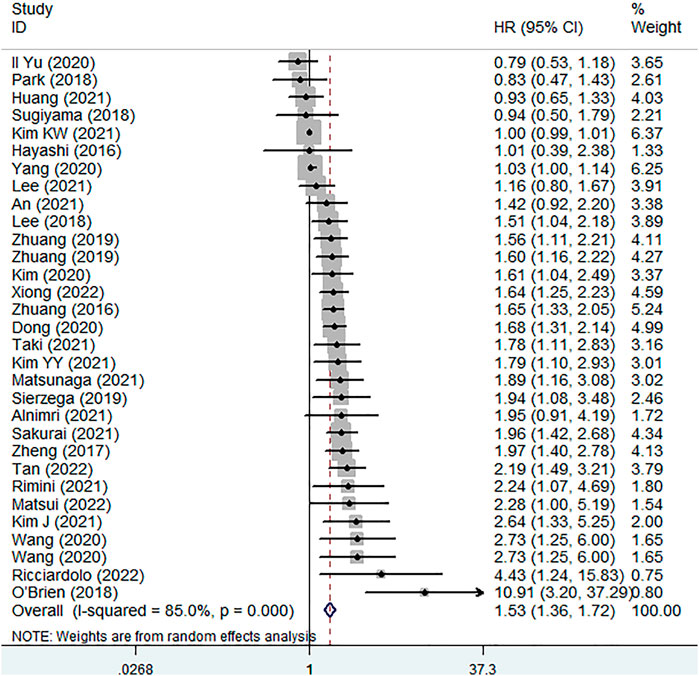
FIGURE 2. The association between pretreatment skeletal muscle index and overall survival in gastric cancer.
Furthermore, the subgroup analysis based on the country (non-China: HR = 1.56, 95% CI: 1.27–1.91, p < 0.001; China: HR = 1.61, 95% CI: 1.29–2.01, p < 0.001) and treatment (non-surgery: HR = 1.56, 95% CI: 1.25–1.95, p < 0.001; surgery: HR = 1.53, 95% CI: 1.35–1.73, p < 0.001) were also conducted and similar results were observed (Table 2).
The association between pretreatment SMI and DFS of gastric cancer patients
Only 13 included studies involving 5,803 patients explored the predictive role of pretreatment SMI for DFS (22, 23, 26, 32, 34–37, 40, 41, 47, 49). The pooled results indicated that lower pretreatment SMI was related with worse DFS (HR = 1.39, 95% CI: 1.13–1.69, p < 0.001; I2 = 58.5%, p = 0.004) (Figure 3).
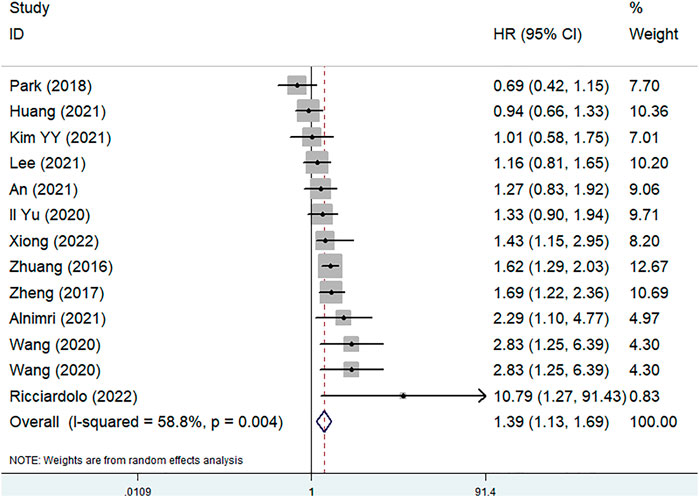
FIGURE 3. The association between pretreatment skeletal muscle index and disease free survival in gastric cancer.
Besides, subgroup analysis based on the country (non-China: HR = 1.22 95% CI: 0.92–1.62, p = 0.001; China: HR = 1.57, 95% CI: 1.19–2.06, p = 0.176) and treatment (surgery: HR = 1.42, 95% CI: 1.15–1.75, p = 0.001) were also performed and similar results were observed (Table 2).
The association between pretreatment SMI and CSS of gastric cancer patients
Only one study involving 1,054 patients explored the predictive role of pretreatment SMI for CSS (44). The results manifested that patients with a lower pretreatment SMI showed significantly worse CSS (HR = 1.96, 95% CI: 1.42–2.68, p < 0.001) (Table 2).
Sensitivity analysis and publication bias
The sensitivity analysis was conducted by excluding each included studies at one time, which indicated that the pooled results of this meta-analysis were stable and reliable and none of each included studies had a significantly impact on the overall results (Figure 4).
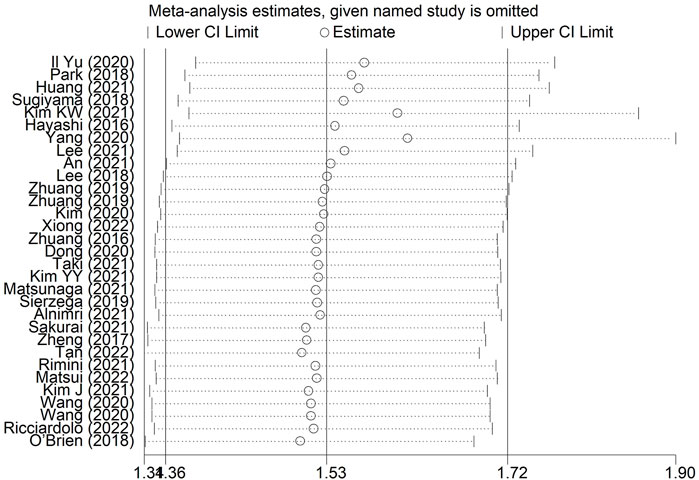
FIGURE 4. Sensitivity analysis about the association between pretreatment skeletal muscle index and overall survival in gastric cancer.
Significant publication bias was observed in our meta-analysis representing as asymmetric Begg’s funnel plot (Figure 5) and p < 0.001 in Egger’s test. Therefore, the trim-and-fill method was further applied. As a result, there were five studies hypothetically remained unpublished for the association between pretreatment SMI and OS (Figure 6). The recalculated result did not change significantly (HR = 1.44, 95% CI: 1.28–1.61, p < 0.001), which indicated the stability of the results.
Discussion
The current meta-analysis demonstrated that pretreatment SMI was significantly associated with OS, DFS and CSS of gastric cancer patients and patients with a lower pretreatment SMI suffered from poorer prognosis after reviewing 31 retrospective studies involving 12,434 patients. Thus, the pretreatment SMI should be considered during the prediction of long-term survival and formulation of appropriate treatment strategies. However, more prospective high-quality studies are still needed to verify above findings.
The SMI is usually applied to define the sarcopenia and a lot of previous literature have showed that SMI is one of the most authoritative indicators to determine the existence of sarcopenia (14, 50, 51). Sarcopenia is a condition characterized by loss of muscle mass and strength, typically associated with aging. Cachexia, on the other hand, is a multifactorial syndrome characterized by loss of muscle mass, weight loss, and systemic inflammation, often seen in chronic diseases such as cancer, heart failure, and AIDS. While both conditions involve loss of muscle mass, cachexia is a more severe and systemic condition that can cause significant morbidity and mortality. In cancer patients, sarcopenia is relatively common compared with cachexia (52). Furthermore, it has been reported that sarcopenia is frequently seen among gastric cancer patients with the incidence of 7%–57.4% in gastric cancer patients (53). Meanwhile, sarcopenia is closely related with worse prognosis of cancer patients (54–56). There are several possible causes to explain why sarcopenia worsens the survival of cancer patients. First, muscle wasting leads to increased inflammatory response (57, 58). Muscle tissue is the largest protein reservoir in the body, and when muscle wasting occurs, a large amount of protein and amino acids are released. These proteins and amino acids enter the bloodstream and stimulate an increase in the inflammatory response, which can promote tumor growth and metastasis (57, 58). Second, muscle wasting leads to decreased nutrient uptake and metabolic capacity (59). Muscle tissue has high energy and nutrient demands, and when muscle wasting occurs, the body’s metabolic rate and energy expenditure also decrease. Moreover, muscle tissue can break down protein to produce amino acids, which are essential building blocks for protein synthesis and cellular function. Muscle wasting can therefore result in amino acid deficiency, which can further affect tumor cell growth and division (59, 60). Third, muscle wasting leads to decreased immune function (61). Muscle tissue is a major reservoir for immune cells, and when muscle wasting occurs, the body’s immune function also decreases. Muscle wasting can also cause immune cells to migrate and impair their function, which reduces the body’s ability to monitor and clear cancer cells (61). Fourth, muscle wasting leads to decreased physical activity (62, 63). Muscle tissue is the primary organ for movement in the body, and when muscle wasting occurs, physical activity also decreases. Muscle wasting can also result in decreased cardiovascular and pulmonary function and reduced endurance, which can lower tolerance for cancer treatment (62, 63). Five, skeletal muscle plays an important role in enduring the chemotherapy and the chemotherapy could cause a significantly increased risk for sarcopenia (64). Thus, cancer patients with sarcopenia show a lower tolerance to chemotherapy and may experience worse therapeutic effects (65). Besides, postoperative skeletal muscle mass loss is also related to more chemotherapy modifications like the dose reduction, delay or termination and has been identified as a risk factor for worse prognosis after gastric cancer surgery, which leads to poorer tumor control and worse survival (48). Furthermore, several studies have indicated that sarcopenia is an independent predictor for worse survival of gastric cancer patients and patient with sarcopenia should be treated more positively (66–69).
Measuring and monitoring a patient’s SMI can help physicians better evaluate a gastric cancer patient’s physical condition and treatment response, and detect and intervene early in cases of malnutrition and muscle rehabilitation issues. In addition, for patients with low SMI, interventions such as reasonable nutritional support and muscle rehabilitation training can improve patients’ quality of life and treatment outcomes. Therefore, SMI can serve as an important indicator for the clinical treatment of gastric cancer patients, guiding and optimizing patients’ treatment plans and nutritional support strategies.
Actually, there are still some valuable fields about the SMI in gastric cancer needing more in-depth investigations. As mentioned above, low SMI is closely related to the adverse events of chemotherapy. Thus, we speculated that the change of SMI during the adjuvant or neoadjuvant chemoradiotherapy may also play an important role in the prediction of long-term survival of gastric cancer patients. Most of relevant studies specified the cutoff values of SMI by sex. However, age is also believed to be an essential factor that significantly affect the baseline condition of skeletal muscle mass. Therefore, more detailed and distinguishing optimal critical values of SMI are wanted, which might contribute to the clinical application of SMI. Besides, a combination of SMI and other valuable prognostic factors like the TNM stage may show higher prognostic value than a single indicator.
There are several limitations in this meta-analysis. First, all included studies are retrospective and the sample size is relatively small. Second, most studies are from Asian countries, which may limit the generalizability of the conclusions. Third, the cut off values of pretreatment SMI differ in included studies, but we could not determine the optimal critical value in this meta-analysis. Fourth, we were unable to conduct more subgroup analysis based on other important parameters such as the age, sex, and TNM stage due to the lack of original data.
Conclusion
Pretreatment SMI was significantly related with prognosis of gastric cancer patients and lower pretreatment SMI predicted much worse survival. However, more prospective high-quality studies are still needed to verify above findings.
Data availability statement
The original contributions presented in the study are included in the article/supplementary material, further inquiries can be directed to the corresponding authors.
Author contributions
YG and DJ conceived and designed the analyses. XH and HL, performed the literature search and selection, collected data, and wrote the paper. XH and SZ performed statistical analyses. All authors contributed substantially to its revision.
Conflict of interest
The authors declare that the research was conducted in the absence of any commercial or financial relationships that could be construed as a potential conflict of interest.
References
1. Bray, F, Ferlay, J, Soerjomataram, I, Siegel, RL, Torre, LA, and Jemal, A. Global cancer statistics 2018: GLOBOCAN estimates of incidence and mortality worldwide for 36 cancers in 185 countries. CA: a Cancer J Clin (2018) 68(6):394–424. doi:10.3322/caac.21492
2. Cao, W, Chen, HD, Yu, YW, Li, N, and Chen, WQ. Changing profiles of cancer burden worldwide and in China: A secondary analysis of the global cancer statistics 2020. Chin Med J (2021) 134(7):783–91. doi:10.1097/CM9.0000000000001474
3. Sung, H, Ferlay, J, Siegel, RL, Laversanne, M, Soerjomataram, I, Jemal, A, et al. Global cancer statistics 2020: GLOBOCAN estimates of incidence and mortality worldwide for 36 cancers in 185 countries. CA: a Cancer J Clin (2021) 71(3):209–49. doi:10.3322/caac.21660
4. Porro, C, La Torre, ME, Tartaglia, N, Benameur, T, Santini, M, Ambrosi, A, et al. The potential role of nutrition in lung cancer establishment and progression. Life (Basel, Switzerland) (2022) 12(2):270. doi:10.3390/life12020270
5. Supportive, PDQ. Palliative care editorial B: Nutrition in cancer care (PDQ®): Health professional version. In: PDQ cancer information summaries. edn. Bethesda (MD): National Cancer Institute US (2002).
6. Takagi, K, Domagala, P, Polak, WG, Buettner, S, Wijnhoven, BPL, and Ijzermans, JNM. Prognostic significance of the controlling nutritional status (CONUT) score in patients undergoing gastrectomy for gastric cancer: A systematic review and meta-analysis. BMC Surg (2019) 19(1):129. doi:10.1186/s12893-019-0593-6
7. Wang, SH, Zhai, ST, and Lin, H. Role of prognostic nutritional index in patients with gastric cancer: A meta-analysis. Minerva Med (2016) 107(5):322–7.
8. Yang, Y, Gao, P, Song, Y, Sun, J, Chen, X, Zhao, J, et al. The prognostic nutritional index is a predictive indicator of prognosis and postoperative complications in gastric cancer: A meta-analysis. Eur J Surg Oncol (2016) 42(8):1176–82. doi:10.1016/j.ejso.2016.05.029
9. Lee, J, Lin, JB, Chen, TC, Jan, YT, Sun, FJ, Chen, YJ, et al. Progressive skeletal muscle loss after surgery and adjuvant radiotherapy impact survival outcomes in patients with early stage cervical cancer. Front Nutr (2021) 8:773506. doi:10.3389/fnut.2021.773506
10. Nose, Y, Yamashita, K, Takeoka, T, Momose, K, Saito, T, Tanaka, K, et al. Perioperative ghrelin administration attenuates postoperative skeletal muscle loss in patients undergoing esophagectomy for esophageal cancer: Secondary analysis of a randomized controlled trial. Ann Surg Oncol (2022) 29:3604–12. doi:10.1245/s10434-022-11436-0
11. Okamoto, A, Aikou, S, Iwata, R, Oya, S, Kawasaki, K, Okumura, Y, et al. The type of gastrectomy affects skeletal muscle loss and the long-term outcomes of elderly patients with gastric cancer: A retrospective study using computed tomography images. Surg Today (2021) 52:812–21. doi:10.1007/s00595-021-02414-2
12. Tang, R, Deng, JP, Zhang, L, Zhang, WW, Sun, JY, Chi, F, et al. Prognostic significance of the skeletal muscle index and systemic inflammatory index in patients with lymph node-positive breast cancer after radical mastectomy. BMC Cancer (2022) 22(1):234. doi:10.1186/s12885-022-09312-x
13. Di Giorgio, A, Rotolo, S, Cintoni, M, Rinninella, E, Pulcini, G, Schena, CA, et al. The prognostic value of skeletal muscle index on clinical and survival outcomes after cytoreduction and HIPEC for peritoneal metastases from colorectal cancer: A systematic review and meta-analysis. Eur J Surg Oncol (2022) 48(3):649–56. doi:10.1016/j.ejso.2021.10.008
14. Tranoulis, A, Kwong, FLA, Lakhiani, A, Georgiou, D, Yap, J, and Balega, J. Prevalence of computed tomography-based sarcopenia and the prognostic value of skeletal muscle index and muscle attenuation amongst women with epithelial ovarian malignancy: A systematic review and meta-analysis. Eur J Surg Oncol (2022) 48:1441–54. doi:10.1016/j.ejso.2022.02.024
15. Xu, L, Jing, Y, Zhao, C, Zhang, Q, Zhao, X, Yang, J, et al. Preoperative computed tomography-assessed skeletal muscle index is a novel prognostic factor in patients with hepatocellular carcinoma following hepatectomy: A meta-analysis. J Gastrointest Oncol (2020) 11(5):1040–53. doi:10.21037/jgo-20-122
16. McLeroy, KR, Northridge, ME, Balcazar, H, Greenberg, MR, and Landers, SJ. Reporting guidelines and the American journal of public health's adoption of preferred reporting Items for systematic reviews and meta-analyses. Am J Public Health (2012) 102(5):780–4. doi:10.2105/AJPH.2011.300630
17. Stang, A. Critical evaluation of the Newcastle-Ottawa scale for the assessment of the quality of nonrandomized studies in meta-analyses. Eur J Epidemiol (2010) 25(9):603–5. doi:10.1007/s10654-010-9491-z
18. Begg, CB, and Mazumdar, M. Operating characteristics of a rank correlation test for publication bias. Biometrics (1994) 50(4):1088–101. doi:10.2307/2533446
19. Egger, M, Davey Smith, G, Schneider, M, and Minder, C. Bias in meta-analysis detected by a simple, graphical test. BMJ (Clinical research ed) (1997) 315(7109):629–34. doi:10.1136/bmj.315.7109.629
20. Wang, Y, Huang, D, Xu, WY, Wang, YW, and Che, GW. Prognostic value of pretreatment lymphocyte-to-monocyte ratio in non-small cell lung cancer: A meta-analysis. Oncol Res Treat (2019) 42(10):523–31. doi:10.1159/000501726
21. Hayashi, N, Ando, Y, Gyawali, B, Shimokata, T, Maeda, O, Fukaya, M, et al. Low skeletal muscle density is associated with poor survival in patients who receive chemotherapy for metastatic gastric cancer. Oncol Rep (2016) 35(3):1727–31. doi:10.3892/or.2015.4475
22. Zhuang, CL, Huang, DD, Pang, WY, Zhou, CJ, Wang, SL, Lou, N, et al. Sarcopenia is an independent predictor of severe postoperative complications and long-term survival after radical gastrectomy for gastric cancer: Analysis from a large-scale cohort. Medicine (Baltimore) (2016) 95(13):e3164. doi:10.1097/MD.0000000000003164
23. Zheng, ZF, Lu, J, Zheng, CH, Li, P, Xie, JW, Wang, JB, et al. A novel prognostic scoring system based on preoperative sarcopenia predicts the long-term outcome for patients after R0 resection for gastric cancer: Experiences of a high-volume center. Ann Surg Oncol (2017) 24(7):1795–803. doi:10.1245/s10434-017-5813-7
24. Lee, JS, Kim, YS, Kim, EY, and Jin, W. Prognostic significance of CT-determined sarcopenia in patients with advanced gastric cancer. Plos One (2018) 13(8):e0202700. doi:10.1371/journal.pone.0202700
25. O'Brien, S, Twomey, M, Moloney, F, Kavanagh, RG, Carey, BW, Power, D, et al. Sarcopenia and post-operative morbidity and mortality in patients with gastric cancer. J Gastric Cancer (2018) 18(3):242–52. doi:10.5230/jgc.2018.18.e25
26. Park, HS, Kim, HS, Beom, SH, Rha, SY, Chung, HC, Kim, JH, et al. Marked loss of muscle, visceral fat, or subcutaneous fat after gastrectomy predicts poor survival in advanced gastric cancer: Single-center study from the CLASSIC trial. Ann Surg Oncol (2018) 25(11):3222–30. doi:10.1245/s10434-018-6624-1
27. Sugiyama, K, Narita, Y, Mitani, S, Honda, K, Masuishi, T, Taniguchi, H, et al. Baseline sarcopenia and skeletal muscle loss during chemotherapy affect survival outcomes in metastatic gastric cancer. Anticancer Res (2018) 38(10):5859–66. doi:10.21873/anticanres.12928
28. Sierzega, M, Chrzan, R, Wiktorowicz, M, Kolodziejczyk, P, and Richter, P. Prognostic and predictive implications of sarcopenia in Western patients undergoing gastric resections for carcinoma of the stomach. J Surg Oncol (2019) 120(3):473–82. doi:10.1002/jso.25509
29. Zhuang, CL, Shen, X, Zou, HB, Dong, QT, Cai, HY, Chen, XL, et al. EWGSOP2 versus EWGSOP1 for sarcopenia to predict prognosis in patients with gastric cancer after radical gastrectomy: Analysis from a large-scale prospective study. Clin Nutr (Edinburgh, Scotland) (2019) 39(7):2301–10. doi:10.1016/j.clnu.2019.10.024
30. Dong, QT, Cai, HY, Zhang, Z, Zou, HB, Dong, WX, Wang, WB, et al. Influence of body composition, muscle strength, and physical performance on the postoperative complications and survival after radical gastrectomy for gastric cancer: A comprehensive analysis from a large-scale prospective study. Clin Nutr (Edinburgh, Scotland) (2020) 40(5):3360–9. doi:10.1016/j.clnu.2020.11.007
31. Kim, EY, Jun, KH, Kim, SY, and Chin, HM. Body mass index and skeletal muscle index are useful prognostic factors for overall survival after gastrectomy for gastric cancer Retrospective cohort study. Medicine (2020) 99(47):e23363. doi:10.1097/MD.0000000000023363
32. Wang, JB, Xue, Z, Lu, J, He, QL, Zheng, ZF, Xu, BB, et al. Effect of sarcopenia on short- and long-term outcomes in patients with gastric neuroendocrine neoplasms after radical gastrectomy: Results from a large, two-institution series. BMC Cancer (2020) 20(1):1002. doi:10.1186/s12885-020-07506-9
33. Yang, W, Xia, F, Wang, J, Zhou, M, Li, G, Shen, L, et al. Quantifying skeletal muscle wasting during chemoradiotherapy with Jacobian calculations for the prediction of survival and toxicity in patients with gastric cancer. Ejso (2020) 46(7):1254–61. doi:10.1016/j.ejso.2020.03.223
34. Yu, JI, Choi, C, Lee, J, Kang, WK, Park, SH, Kim, ST, et al. Effect of baseline sarcopenia on adjuvant treatment for D2 dissected gastric cancer: Analysis of the ARTIST phase III trial. Radiother Oncol : J Eur Soc Ther Radiol Oncol (2020) 152:19–25. doi:10.1016/j.radonc.2020.07.043
35. Alnimri, F, Sivakumar, J, Sutherland, T, Johnson, MA, Ward, S, Chong, L, et al. Pre-operative low muscle mass is associated with major complications and lower recurrence-free survival after gastric cancer surgery. Anz J Surg (2021) 91(3):316–22. doi:10.1111/ans.16590
36. An, S, Eo, W, and Kim, Y-J. Muscle-related parameters as determinants of survival in patients with stage I-III gastric cancer undergoing gastrectomy. J Cancer (2021) 12(18):5664–73. doi:10.7150/jca.61199
37. Huang, DD, Yu, DY, Song, HN, Wang, WB, Luo, X, Wu, GF, et al. The relationship between the GLIM-defined malnutrition, body composition and functional parameters, and clinical outcomes in elderly patients undergoing radical gastrectomy for gastric cancer. Eur J Surg Oncol (2021) 47(9):2323–31. doi:10.1016/j.ejso.2021.02.032
38. Kim, J, Han, SH, and Kim, H-I. Detection of sarcopenic obesity and prediction of long-term survival in patients with gastric cancer using preoperative computed tomography and machine learning. J Surg Oncol (2021) 124(8):1347–55. doi:10.1002/jso.26668
39. Kim, KW, Lee, K, Lee, JB, Park, T, Khang, S, Jeong, H, et al. Preoperative nutritional risk index and postoperative one-year skeletal muscle loss can predict the prognosis of patients with gastric adenocarcinoma: A registry-based study. BMC Cancer (2021) 21(1):157. doi:10.1186/s12885-021-07885-7
40. Kim, YY, Lee, J, Jeong, WK, Kim, ST, Kim, JH, Hong, JY, et al. Prognostic significance of sarcopenia in microsatellite-stable gastric cancer patients treated with programmed death-1 inhibitors. Gastric Cancer (2021) 24(2):457–66. doi:10.1007/s10120-020-01124-x
41. Lee, JK, Park, YS, Lee, K, Youn, SI, Won, Y, Min, SH, et al. Prognostic significance of surgery-induced sarcopenia in the survival of gastric cancer patients: A sex-specific analysis. J Cachexia Sarcopenia Muscle (2021) 12(6):1897–907. doi:10.1002/jcsm.12793
42. Matsunaga, T, Saito, H, Miyauchi, W, Shishido, Y, Miyatani, K, Morimoto, M, et al. Impact of skeletal muscle mass in patients with unresectable gastric cancer who received palliative first-line chemotherapy based on 5-fluorouracil. Bmc Cancer (2021) 21(1):1219. doi:10.1186/s12885-021-08953-8
43. Rimini, M, Pecchi, A, Prampolini, F, Bussei, C, Salati, M, Forni, D, et al. The prognostic role of early skeletal muscle mass depletion in multimodality management of patients with advanced gastric cancer treated with first line chemotherapy: A pilot experience from modena cancer center. J Clin Med (2021) 10(8):1705. doi:10.3390/jcm10081705
44. Sakurai, K, Kubo, N, Tamamori, Y, Aomatsu, N, Nishii, T, Tachimori, A, et al. Depletion of skeletal muscle mass adversely affects long-term outcomes for men undergoing gastrectomy for gastric cancer. Plos One (2021) 16(8):e0256365. doi:10.1371/journal.pone.0256365
45. Taki, Y, Sato, S, Nakatani, E, Higashizono, K, Nagai, E, Nishida, M, et al. Preoperative skeletal muscle index and visceral-to-subcutaneous fat area ratio are associated with long-term outcomes of elderly gastric cancer patients after gastrectomy. Langenbecks Arch Surg (2021) 406(2):463–71. doi:10.1007/s00423-021-02092-1
46. Matsui, R, Inaki, N, and Tsuji, T. Impact of diabetes mellitus on long-term prognosis after gastrectomy for advanced gastric cancer: A propensity score matching analysis. Surg Today (2022) 52:1382–91. doi:10.1007/s00595-022-02482-y
47. Ricciardolo, AA, De Ruvo, N, Serra, F, Prampolini, F, Solaini, L, Battisti, S, et al. Strong impact of sarcopenia as a risk factor of survival in resected gastric cancer patients: First Italian report of a bicentric study. Updates Surg (2022) 74(1):283–93. doi:10.1007/s13304-021-01175-4
48. Tan, S, Zhuang, Q, Zhang, Z, Li, S, Xu, J, Wang, J, et al. Postoperative loss of skeletal muscle mass predicts poor survival after gastric cancer surgery. Front Nutr (2022) 9:794576. doi:10.3389/fnut.2022.794576
49. Xiong, J, Hu, H, Kang, W, Shao, X, Li, Y, Jin, P, et al. Association of sarcopenia and expression of interleukin-16 in gastric cancer survival. Nutrients (2022) 14(4):838. doi:10.3390/nu14040838
50. Chen, F, Chi, J, Zhao, B, Mei, F, Gao, Q, Zhao, L, et al. Impact of preoperative sarcopenia on postoperative complications and survival outcomes of patients with esophageal cancer: A meta-analysis of cohort studies. Dis Esophagus : Off J Int Soc Dis Esophagus (2022) 35:doab100. doi:10.1093/dote/doab100
51. Li, S, Wang, T, Lai, W, Zhang, M, Cheng, B, Wang, S, et al. Prognostic impact of sarcopenia on immune-related adverse events in malignancies received immune checkpoint inhibitors: A systematic review and meta-analysis. Transl Cancer Res (2021) 10(12):5150–8. doi:10.21037/tcr-21-1470
52. Dolin, TG, Mikkelsen, MK, Jakobsen, HL, Vinther, A, Zerahn, B, Nielsen, DL, et al. The prevalence of sarcopenia and cachexia in older patients with localized colorectal cancer. J Geriatr Oncol (2023) 14(1):101402. doi:10.1016/j.jgo.2022.11.001
53. Petermann-Rocha, F, Balntzi, V, Gray, SR, Lara, J, Ho, FK, Pell, JP, et al. Global prevalence of sarcopenia and severe sarcopenia: A systematic review and meta-analysis. J Cachexia Sarcopenia Muscle (2022) 13(1):86–99. doi:10.1002/jcsm.12783
54. Takenaka, Y, Takemoto, N, Oya, R, and Inohara, H. Prognostic impact of sarcopenia in patients with head and neck cancer treated with surgery or radiation: A meta-analysis. PLoS One (2021) 16(10):e0259288. doi:10.1371/journal.pone.0259288
55. Waalboer, RB, Meyer, YM, Galjart, B, Olthof, PB, van Vugt, JLA, Grünhagen, DJ, et al. Sarcopenia and long-term survival outcomes after local therapy for colorectal liver metastasis: A meta-analysis. HPB : Off J Int Hepato Pancreato Biliary Assoc (2022) 24(1):9–16. doi:10.1016/j.hpb.2021.08.947
56. Watanabe, J, Matsui, R, Sasanuma, H, Ishizaki, Y, Fukunaga, T, Kotani, K, et al. Body composition assessment and sarcopenia in patients with biliary tract cancer: A systematic review and meta-analysis. Clin Nutr (Edinburgh, Scotland) (2022) 41(2):321–8. doi:10.1016/j.clnu.2021.12.005
57. Schiaffino, S, Dyar, KA, Ciciliot, S, Blaauw, B, and Sandri, M. Mechanisms regulating skeletal muscle growth and atrophy. FEBS J (2013) 280(17):4294–314. doi:10.1111/febs.12253
58. Webster, JM, Kempen, L, Hardy, RS, and Langen, RCJ. Inflammation and skeletal muscle wasting during cachexia. Front Physiol (2020) 11:597675. doi:10.3389/fphys.2020.597675
59. Ekramzadeh, M, Santoro, D, and Kopple, JD. The effect of nutrition and exercise on body composition, exercise capacity, and physical functioning in advanced CKD patients. Nutrients (2022) 14(10):2129. doi:10.3390/nu14102129
60. Dasarathy, S, and Merli, M. Sarcopenia from mechanism to diagnosis and treatment in liver disease. J Hepatol (2016) 65(6):1232–44. doi:10.1016/j.jhep.2016.07.040
61. Tian, J, Chung, HK, Moon, JS, Nga, HT, Lee, HY, Kim, JT, et al. Skeletal muscle mitoribosomal defects are linked to low bone mass caused by bone marrow inflammation in male mice. J Cachexia Sarcopenia Muscle (2022) 13(3):1785–99. doi:10.1002/jcsm.12975
62. Nishikawa, H, Fukunishi, S, Asai, A, Yokohama, K, Nishiguchi, S, and Higuchi, K. Pathophysiology and mechanisms of primary sarcopenia (Review). Int J Mol Med (2021) 48(2):156. doi:10.3892/ijmm.2021.4989
63. Pár, A, Hegyi, JP, Váncsa, S, and Pár, G. Sarcopenia - 2021: Pathophysiology, diagnosis, therapy. Orvosi Hetilap (2021) 162(1):3–12. doi:10.1556/650.2021.32015
64. Awad, S, Tan, BH, Cui, H, Bhalla, A, Fearon, KC, Parsons, SL, et al. Marked changes in body composition following neoadjuvant chemotherapy for oesophagogastric cancer. Clin Nutr (Edinburgh, Scotland) (2012) 31(1):74–7. doi:10.1016/j.clnu.2011.08.008
65. Palmela, C, Velho, S, Agostinho, L, Branco, F, Santos, M, Santos, MP, et al. Body composition as a prognostic factor of neoadjuvant chemotherapy toxicity and outcome in patients with locally advanced gastric cancer. J Gastric Cancer (2017) 17(1):74–87. doi:10.5230/jgc.2017.17.e8
66. Erkul, O, Cekic, AB, Cansu, A, Yildirim, R, and Guner, A. Effects of sarcopenia on postoperative outcomes in patients who underwent gastrectomy for gastric cancer. J Surg Res (2022) 274:196–206. doi:10.1016/j.jss.2021.12.051
67. Hisada, H, Tamura, N, Tsuji, Y, Nagao, S, Fukagawa, K, Miura, Y, et al. The impact of sarcopenia on adverse events associated with gastric endoscopic submucosal dissection. Surg Endosc (2022) 36:6387–95. doi:10.1007/s00464-021-08965-2
68. Huang, ZX, Zhang, HH, Zhang, WT, Shi, MM, Ren, JH, Xu, LB, et al. Effect of short-term preoperative parenteral nutrition support for gastric cancer patients with sarcopenia: A propensity score matching analysis. J Gastrointest Surg (2022) 26:1362–72. doi:10.1007/s11605-021-05185-w
Keywords: meta-analysis, prognosis, gastric cancer, pretreatment, skeletal muscle index
Citation: He X, Zhou S, Li H, Gou Y and Jia D (2023) Prognostic role of pretreatment skeletal muscle index in gastric cancer patients: A meta-analysis. Pathol. Oncol. Res. 29:1611055. doi: 10.3389/pore.2023.1611055
Received: 11 January 2023; Accepted: 12 April 2023;
Published: 24 April 2023.
Edited by:
Aniko Maraz, University of Szeged, HungaryCopyright © 2023 He, Zhou, Li, Gou and Jia. This is an open-access article distributed under the terms of the Creative Commons Attribution License (CC BY). The use, distribution or reproduction in other forums is permitted, provided the original author(s) and the copyright owner(s) are credited and that the original publication in this journal is cited, in accordance with accepted academic practice. No use, distribution or reproduction is permitted which does not comply with these terms.
*Correspondence: Yue Gou, Mzk2ODEyNDYyQHFxLmNvbQ==; Dan Jia, NDE3NTIyNzc0QHFxLmNvbQ==
 Xiaohong He1,2
Xiaohong He1,2 Yue Gou
Yue Gou